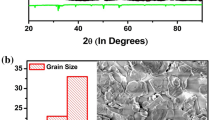Abstract
A considerable change in the electric conductivity of barium-bismuth titanate (IV) when doped with ferric oxide has been observed. In order to explain the origin of its semiconductive properties a substitution model is presented. This model assumes the entrance of Fe3+ ions into the crystalline lattice in three subsequent stages which mutually differ in the lattice position of the introduced Fe ion and in the compensation mechanism of the inequilibrium electric charge of the lattice ions. The validity of the proposed model is supported by the anomalous behaviour of the resistance, activation energy, type of conductivity, Curie temperature, internal stress and change in the size of crystals of the polycrystalline materials as a function of the amount iron they contain.
Similar content being viewed by others
References
Aingler F. E., Herbert J. M.: Trans. Brit. Ceram. Soc.58 (1959), 410.
Arend H., Coufová P.: Czech. J. Phys.B 13 (1963), 55.
Arnold R. T., Stanfors A. D. jun.: J. Chem. Phys.41 (1964), 1520.
Baxter P., Hellicar N. J., Lewis B.: J. Amer. Ceram. Soc.42 (1959), 645.
Bogdanov S. V. et al.: Izv. Akad. nauk SSSR, ser. flz.29 (1965), 994.
Diamond J., Chang V.: US Government Research Reports30 (1958), 418.
Lapluye G., Morinet G., Palla P.: Compt. Rend. Acad. Sci. (Paris)250 (1960), 79.
Nishioka A., Sekihawa K., Owaki M.: J. Phys. Soc. Japan11 (1956), 180.
Sakudo T.: J. Phys. Soc. Japan12 (1957), 1050.
Saburi O.: J. Phys. Soc. Japan14 (1959), 1159.
Saburi O.: Experimental Research in Semiconducting Barium Titanates, Technical Laboratory of Murata Mfg. Co. Ltd. Nagaoka-cho, Kyoto (Japan) 1961.
Bogdanov S. V., Kiseleva K. V., Rassusin V. A.: Kristallografija10 (1965), 74.
Fang P. H., Robina C., Forra F.: Compt. Rend. Acad. Sci. (Paris)252 (1961), 683.
Skanavi G. J., Ksendzov Ja. M.: Ž. exper. teor. fiz.33 (1957), 320.
Šroubek Z.: (Institute of Radio Engineering and Electronics, Czechosl. Acad. Sci.) Private Communication.
Jonker G. H., van Houten S.: Halbleiterprobleme6 (1961), 118.
Author information
Authors and Affiliations
Additional information
The author considers it his duty to thank his collaborators from the Research Institute of Electrotechnical Ceramics for effective help: Ing. VI. Koukal for the measurements of the semiconductive properties, Ing. L. Plocek for the roentgenographical analyses and Mr. V. Štefek for preparing the electron microscope pictures.
Rights and permissions
About this article
Cite this article
Schwarzbach, J. On the origin of the semiconductivity of ceramic barium-bismuth titanate (IV) doped with iron. Czech J Phys 17, 906–916 (1967). https://doi.org/10.1007/BF01691642
Received:
Issue Date:
DOI: https://doi.org/10.1007/BF01691642




